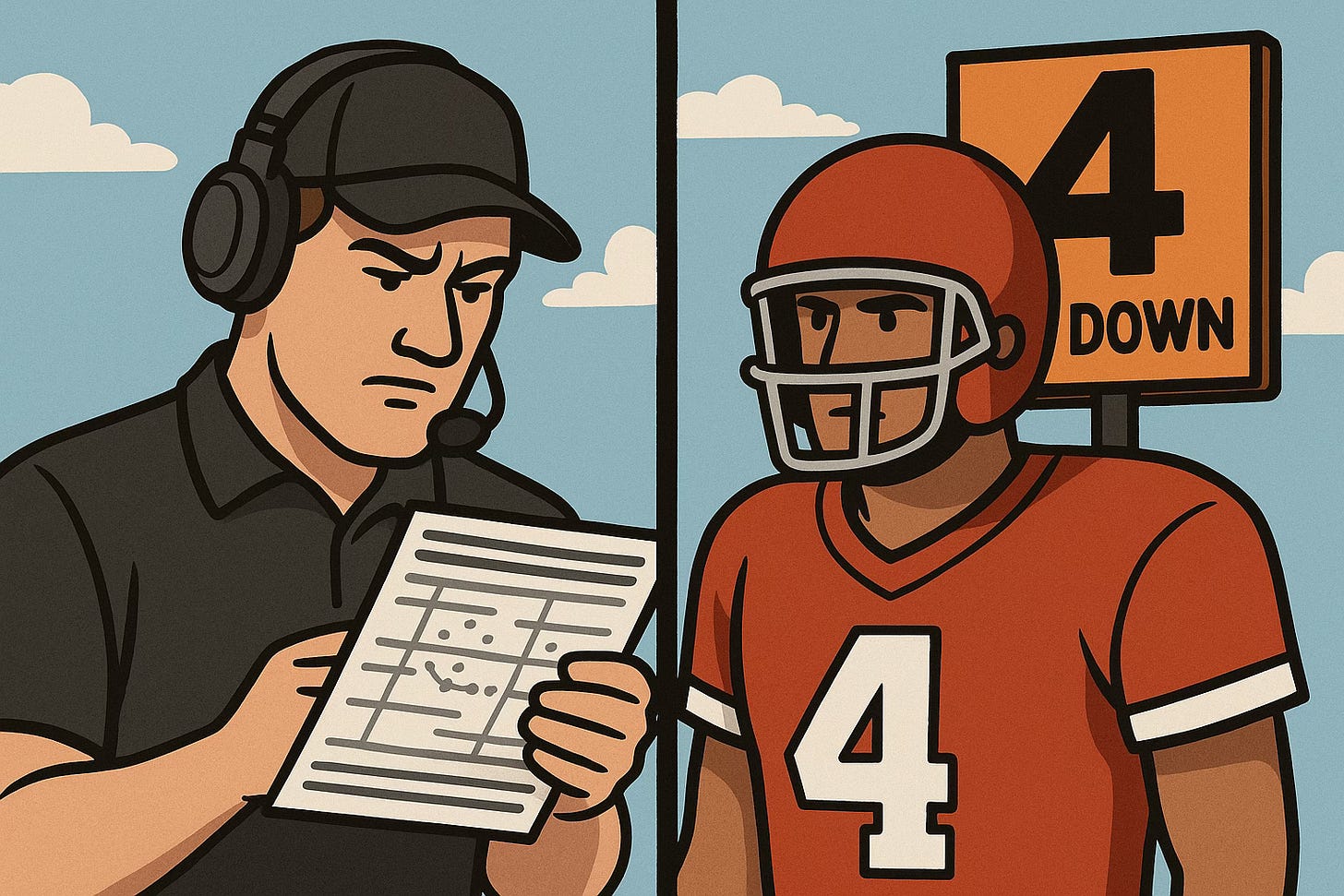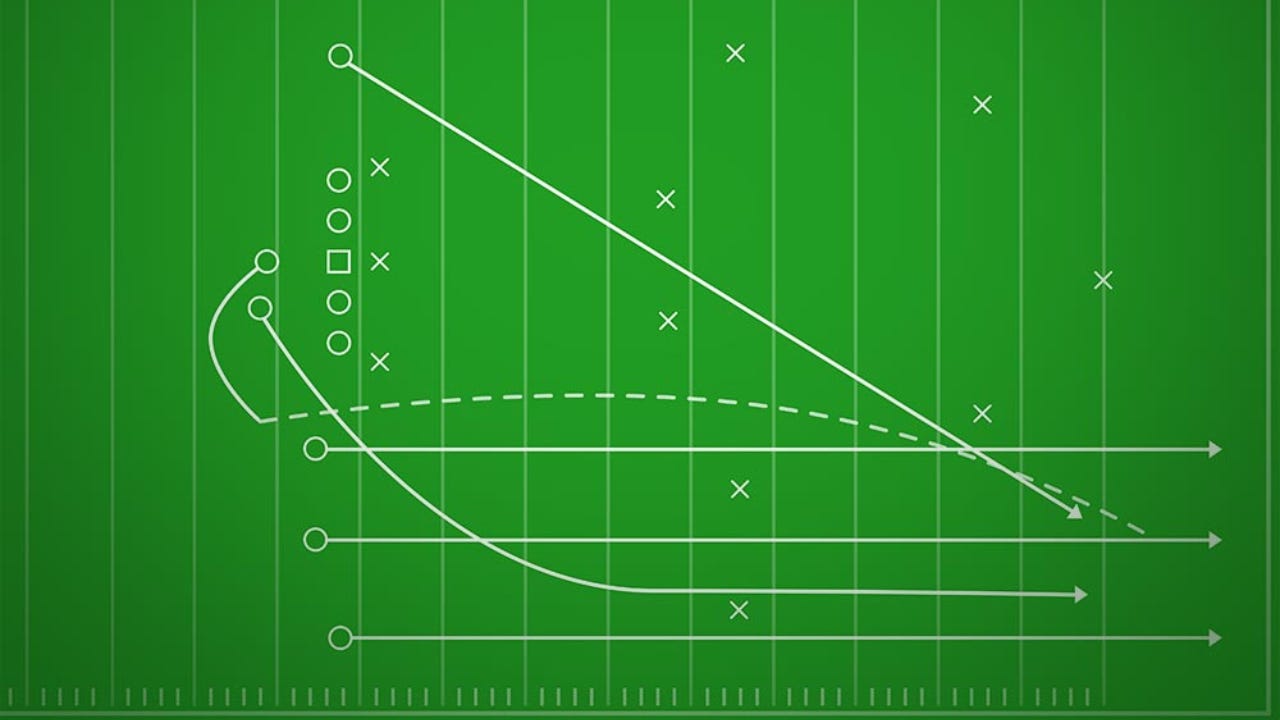8 Situations You Must Script Every Week
The weekly script that eliminates guesswork on game night.
Most coaches have no problem drawing up their system and preparing for 1st and 2nd down between the 20s. And while that’s where a bulk of the game is played, it’s not where most games are won.
Games are won and lost in high-leverage situations. Great coaches have a plan when those moments hit.
We love to label a team or coach as “clutch,” but the truth is they’re just the most prepared. If you’re trying to call plays off the cuff when the game’s on the line, you’re already at a disadvantage.
That’s why we script and practice these critical situations every single week.
In the early season, we install each situation as its own teaching period. Later in the year, we work hard to keep those moments sharp and distinct. It not only helps players anticipate the call, but it also helps you, the play-caller, eliminate hesitation and think clearly when the pressure hits.
Here are the 8 situations we make sure to rep every single week.
1. 1st and 15 or 20
Penalties are going to happen. As coordinators, we have to understand that the math shifts immediately. On 1st and 20, you’re looking at needing roughly 6.6 yards per play to move the chains. On 1st and 15, it’s 5.
That means you don’t need to get it all back at once, and you shouldn’t try to. Avoid the temptation to take a low-percentage deep shot just to “get back on schedule.”
Our approach is to lean into high-percentage intermediate concepts or play-action calls we trust. The goal is to stay composed, take what’s there, and keep the drive alive.
2. 3rd & 4th Down – All Distance
These are down-to-go situations. Your ability to convert determines whether you’re punting or keeping the drive alive.
And the data is clear: 3rd down efficiency is one of the strongest indicators of overall win percentage. This phase of the game can’t be an afterthought.
We break these scenarios into three categories and script calls for each one:
1–3 Yards
You’ve got options here. If the run game is cooking, ride the momentum and stick with your bread and butter.But when we script for short-yardage, we usually lean into heavier personnel packages, something that brings an edge physically and gives us multiple ways to win at the point of attack.
Having a rub play or a quick flat pass is also a good idea.
4–7 Yards
This is the gray area. It’s usually too far for a reliable run (especially against evenly matched opponents), but it’s not quite desperate. This is where your full menu of play-action and drop-back passes opens up. We like horizontal stretch concepts here: Curl/Flat, Flood, Y-Cross, Mesh—anything that creates windows in the intermediate zones and gets the ball out on time.8+ Yards
Now we’re in a true passing down, and the defense knows it. This is where scripting becomes crucial. You must:Have an answer for pressure
Have an answer for drop-8 coverage
Our philosophy here? Don’t settle for a quick check-down on 3rd and 9 unless it's part of a bigger YAC plan. This might be the one time we lean on max protection or rollout schemes.
I like deep curl routes, comebacks, or isolated deep outs. You're not going to hit on every 3rd & long, but you can give yourself a chance to stay on the field with smart, rehearsed calls.
3. Backed Up – Inside Our Own 5
There are two schools of thought here, and we prepare for both:
Option 1: Max Protect and Take a Shot
When defenses smell blood, they often bring pressure and crowd the box, hoping for a sack or safety. That aggressive posture usually creates one-on-one matchups outside. If you trust your protection (and I recommend heavy sets with max protection), this can be a prime opportunity to hit a deep shot or draw a pass interference. .
Option 2: Treat It Like Short Yardage
If the shot isn't there or if it doesn’t fit your identity, this becomes a field position battle. Get into a heavy set, shift or motion to create angles, and grind out a few yards. Your goal is to give your offense some breathing room and avoid mistakes.
In this approach, you're not chasing explosives, you’re playing smart, physical football.
4. Goal Line / Short Yardage (1–3 Yards)
Finishing drives is a non-negotiable for any successful offense. Whether it’s 3rd-and-1, 4th-and-inches, or a goal line stand, this is where games are won.
Here’s what we know in these situations:
The box will be loaded. If the defense can fit 11 guys near the LOS, they will.
They’ll play man. It’s about winning your matchup and being more physical than the guy across from you.
We build our plan around two primary strategies:
1. Pack the Box and Outnumber Them
We’ll load up with fullbacks, extra tight ends, and bring shifts and motions to the party. The goal is to outnumber at the point of attack and create angles.
2. Spread Them Out and Create Matchups
We’ll also script from 11 or even 10 personnel, using motion to force communication and create natural rubs or picks.
One of our favorite calls? Motion into a double slant/flat combo. It’s a high-percentage, low-risk way to score or move the chains in tight space.
We fold our 2-point play period into this session to kill two birds with one stone. And don’t forget, on 2-point plays, you get to pick your hash.
5. 2-Minute Offense
Probably the most repped situation in football, and for good reason. Almost every coach includes a 2-minute segment in weekly prep.
How much time you dedicate depends on your system. A spread team might only need to hit it once a week. But if you’re running something like Flexbone, Wing-T, or another ball-control system, you’ll likely need extra reps to feel confident in a fast-paced passing situation.
What works in 2-minute?
Forget the deep ball—most defenses are playing soft coverage to keep everything in front. Instead, we prioritize:
Horizontal stretch concepts that work the sidelines or create easy completions.
Situational screens and draws, especially against drop-7 or drop-8 looks where rush lanes are soft and defenders are flying to depth.
You’re not looking for explosives—you’re looking for efficient chunks that move the chains, stop the clock, and keep the pressure on.
6. 4-Minute Offense
Just like the 2-minute drill demands extra work for some systems, the 4-minute offense demands work from the opposite.
If you’re a Flexbone, Wing-T, Single Wing, or any ground-control offense, you live in 4-minute mode by default. You don’t need a ton of extra reps because your base identity is already built for it.
But if you're a balanced team or one that leans on quick passes, screens, and tempo to move the ball, then you do need to script this scenario intentionally.
The 4-minute offense comes into play when you're ahead late against an evenly matched opponent. The mission:
Bleed the clock
Limit possessions
Secure the win
Defenses will get aggressive here.
They’ll blitz more, crowd the box, and take risks to get a stop. That means your 4-minute package needs to resemble your short-yardage/goal-line package. You want to control the line of scrimmage and earn tough yards.
If you’re a tempo team, this is also the time to practice slowing things down. Sugar huddle, get to the line late, use the full play clock. Don’t just rely on your default rhythm.
And whatever you do, don’t go three-and-out and burn 20 seconds off the clock. That’s a gift for your opponent.
7. Sudden Change Situations
Sudden Change refers to the first play after a turnover, when your defense just gave you the ball, and the momentum is swinging in your favor.
This is a golden opportunity to deliver a psychological blow to the opponent. Whether you're trying to spark a comeback or bury a team that’s already reeling, this moment matters.
Because it’s a change of possession, your offense is on the sideline. That means you have a brief window to huddle up and call your best shot, with clarity.
We treat Sudden Change as a green light moment.
We’re dialing up our favorite shot play.
If it hits, it creates a momentum shift that can flip a game. And even if it doesn’t, it forces the defense to defend the full field again, immediately.
8. Hail Mary / Last Play Scenarios
These are desperate situations. Odds of converting are low, but that doesn’t mean you leave it to chance.
Repping this once or twice a week gives your kids a plan if it ever comes up. It also helps you define your quarterback’s range to the end zone, which is something most coaches overlook until it’s too late.
Our approach is simple:
If we’re within range, we throw a jump ball to our best athlete and always send a trailing player from the backside in case of a tipped ball.
If we’re out of range, we complete a short pass and start the lateral game. It's not pretty, but at least it’s practiced chaos.
We don’t burn much practice time here, just a couple of reps per week. But if that moment ever comes, at least we’re not drawing it in the dirt.
Conclusion
We have most of these situations scripted into practice throughout the week, but Thursday is what we call Chaos. That’s when we throw every one of these scenarios at our players in no particular order.
It’s not just about repping plays, it’s about training focus. We want our players mentally locked in, because that’s exactly what Friday nights demand.
This script didn’t come from a clinic or a manual. It came from years of trial and error, heartbreaking losses, and game-winning drives.
Every season, we tweak it. Add to it. Refine it.
Games are won and lost in situations, not between the 20s, and not on your call sheet’s first page.
Prepare your kids for the moments that matter most. Because when the pressure hits, your plan is either ready or it isn’t.





where is #5 located?
Great article, thank you!